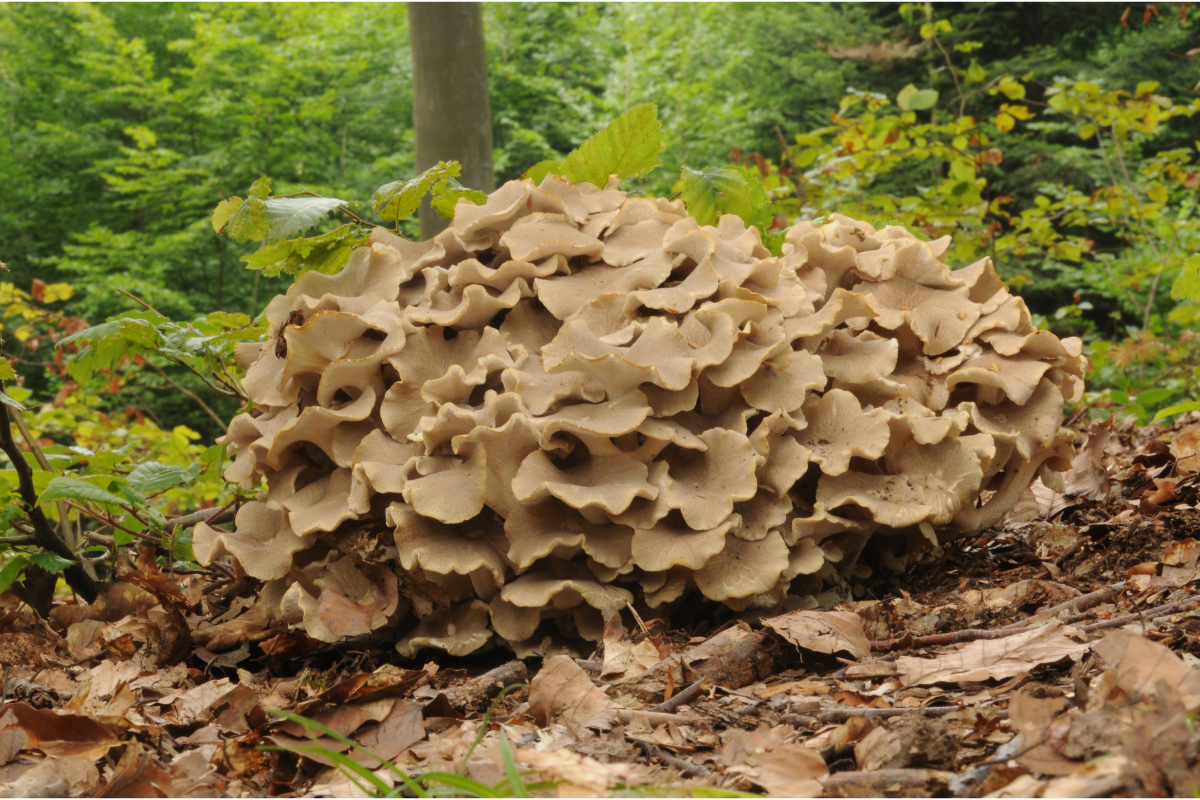Polyporus, often overlooked, is a treasure trove of mycotherapy, the science of the health benefits of fungi. In this article, we delve deep into the fascinating world of this forest mushroom, exploring its characteristics, its natural health benefits, and its use in traditional and modern remedies. This text aims to provide a comprehensive and up-to-date understanding of Polyporus, making it accessible and interesting to any reader curious about mycotherapy and natural pharmacology.
What is mycotherapy?
Mycotherapy is a branch of natural medicine that focuses on the study and use of fungi for therapeutic purposes. It is based on exploiting the medicinal properties of mushrooms, which are recognised for their bioactive compounds that are beneficial to human health. This practice, which combines ancestral tradition with modern scientific research, explores how mushrooms can contribute to the prevention and treatment of various illnesses, boosting the immune system and offering natural alternatives for maintaining good health.
What’s the difference between mycotherapy and mycology?
Although related, mycotherapy and mycology are two distinct disciplines. Mycology is the science that studies fungi from every angle: biological, ecological and taxonomic. It is concerned with the classification, structure and evolution of fungi. Mycotherapy, on the other hand, focuses specifically on the therapeutic use of fungi. It explores how the active substances in fungi can be used to improve health and treat various pathologies.
What is a mycologist?
A mycologist is a scientist who specialises in the study of fungi. This expertise covers various fields such as the identification, classification, ecology and biology of fungi. Mycologists play a crucial role in understanding the ecological impact of fungi, as well as exploring their potential uses in medicine, agriculture and biotechnology. Their work contributes not only to scientific knowledge of fungi, but also to the identification of new practical applications for these organisms in various sectors.
Famous mycologists include Elias Magnus Fries, considered to be the father of modern mycology, and Paul Stamets, renowned for his research into the use of fungi in bioremediation and medicine. These experts have made a major contribution to our current understanding of fungi and their extraordinary potential.
What is Polyporus?
Before delving into the specific details of Polyporus, it is essential to understand its unique place in the fungal kingdom. Beyond its distinctive appearance, this fungus offers a wealth of properties and applications that make it particularly intriguing for mycology enthusiasts and natural medicine practitioners. In the following sections, we’ll explore its classification, structure and the many facets that set Polyporus apart from the rest.
Synonyms and common names of Polyporus umbellatus
Polyporus umbellatus, a multi-faceted mushroom, is known by many different names around the world. In Chinese medicine, the mushroom is often called Zhuling, a name which reflects its long history in traditional medicinal practices. In some cultures, it is also known as Grifola, reflecting its unique texture. Sometimes referred to as Chorei, this mushroom is also known as Polypore en ombelle in French, a direct reference to its characteristic umbrella-shaped appearance. The identification of these various names highlights the cultural richness and international reach of Polyporus umbellatus, reflecting its important place in the world of mycotherapy (12).
A. Classification and description
Polyporus, scientifically named Polyporus umbellatus, belongs to the Polyporaceae family. This edible mushroom is remarkable for its inverted umbrella shape and grows near or on deciduous trees, particularly oaks, beeches and maples. Its fruiting body consists of numerous (sometimes several hundred) caps, each 1 to 4 cm in diameter, light brown in colour and heavily umbilicated. These caps are located at the ends of a robust, highly branched stalk, which can measure up to 40 cm in diameter. The pores of the mushroom are narrow and white, and the stem is grey-white in colour, emerging from an underground tuberous nodule. The flesh is white and tender when young, but hardens with age. (1)(2)
B. Habitat and seasonality
Polyporus is found mainly in tropical and temperate regions of the northern hemisphere. It adopts a lifestyle that is both parasitic and saprophytic, growing on the roots and wood of hardwood trees and continuing to decompose the wood after the tree has died. As a result, the fungi always appear on the ground. Polyporus is widespread in North America, Asia and Europe. It has been used for over 1000 years in Chinese medicine and is said to have been found among the personal effects of Ötzi, the mummified ice man, discovered on an Austrian glacier. (3)
C. Bioactive compounds and medicinal properties of Polyporus
Polyporus is distinguished by its wealth of bioactive compounds, offering significant therapeutic potential for human health. These compounds include :
- Beta-glucans: These polysaccharides play a key role in supporting the immune system and preventing infections. They have also been associated with immunostimulant effects, essential for combating various diseases.
- Proteoglycans: These protein structures are crucial in the formation of connective tissue, contributing to the overall health of the body.
- Triterpenes: These versatile compounds have multiple functions in the body, including anti-inflammatory and anti-cancer activities.
- Mineral Richness: Polyporus is a source of essential minerals such as calcium, potassium, iron, manganese and zinc, all of which are vital for various bodily functions.
- B-group vitamins: These vitamins play a crucial role in maintaining nerve and energy health.
- Ergosterol: A precursor of vitamin D, ergosterol is important for bone health and immune function.
Scientific studies have highlighted the beneficial effects of Polyporus in various medical contexts. For example, Tan XL, Guo L et al.found that Polyporus umbellatus inhibited tumour cell proliferation and promoted apoptosis in breast cancer (4). Zhang GW et al. demonstrated the efficacy of Polyporus polysaccharide, in combination with BCG, in inhibiting bladder carcinoma (5). Other studies, such as those by Yoon JJ et al, have highlighted the protective effect of Polyporus against mesangial fibrosis (6) induced by high concentrations of glucose.
In short, Polyporus is a multi-faceted mushroom, offering not only nutritional benefits but also promising therapeutic properties. Its wealth of bioactive compounds makes it particularly interesting for research into natural medicine and mycotherapy.
D. Chemical composition and nutritional applications
Polyporus umbellatus has a rich and varied chemical composition. It contains a range of essential fatty acids,amino acids and minerals, all of which contribute to its beneficial properties. In addition to its therapeutic applications, this mushroom plays an important role in nutrition. Rich in nutrients, it can be incorporated into a balanced diet, providing support for cardiovascular health and general well-being.
E. Biology and ecological cultivation of Polyporus umbellatus
Polyporus umbellatus belongs to the order Poriales and the family Poriaceae, sharing the genus Grifola with maitake (Grifola frondosa). This species is saprophytic, feeding on decaying wood. It turns from soft white to hard woody as it matures. It is often found in the wild in forests, sometimes weighing up to 20 kg. The underground sclerotia of this mushroom resembles a truffle, hence its nickname of “pig fungus” in some cultures. Studies have highlighted its wealth of bioactive substances (13).
Growing Polyporus
This medicinal mushroom grows on woody substrates, particularly oak and beech. It can be grown in controlled conditions in bags containing organic substrates from these trees. Organic cultivation is essential, as the fungi act as “bioremediators”bioremediators“They can absorb heavy metals from their environment. For therapeutic use, it is advisable to opt for organic mushrooms grown in bioreactors on specific organic substrates to optimise the quantity and quality of their active biomolecules.
Use in traditional and modern medicine
Polyporus umbellatus is a mushroom that has long been valued in traditional medicine and is now attracting growing interest in modern medical research for its various therapeutic properties.
Traditional medicine
Polyporus, known as Zhuling in traditional Chinese medicine, has a long history of use in treating a variety of disorders. It is particularly renowned for its effect diuretic effect effective against oedema, urinary dysfunction and water retention (7). It is also used to manage vaginal discharge, jaundice and diarrhoea. In addition to these applications in China, Polyporus has been used in other Asian medicinal traditions for respiratory problems and urinary tract infections, underlining its versatility and effectiveness across different cultures.
Applications in modern medicine
- Antitumour effects: Studies have shown that polysaccharides extracted from Polyporus can inhibit the growth of various forms of cancer. These compounds reduced the growth of Sarcoma 180 and Ehrlich solid cancers in mice by 70% and 80% respectively. The mushroom has also demonstrated anti-tumour effects in Japanese studies and has been effective in reducing post-operative recurrence rates of bladder cancer.
- Kidney and Urological problems: Polyporus has been used to prevent and treat kidney stones and urinary tract infections. It is considered an effective natural diuretic with no significant side effects, used to treat pyelonephritis, nephritis and urological stones (9).
- Antioxidant and immunostimulant activity: Studies have shown that Polyporus has antioxidant and free radical scavenging activities. It has also been shown to improve cellular immunity in mice, including those with liver damage.
- Hair Growth research has indicated that Polyporus can promote hair growth. Studies on mice and human hair follicle cultures have identified active components in the fungus that stimulate hair growth (10).
- Antiviral and anti-protozoal properties: Although further studies are required, some research suggests that Polyporus may have activity against chronic hepatitis B and Chlamydia trachomatis infection. It has also shown inhibitory activity against the protozoan Plasmodium falciparum, one of the main causative agents of malaria (11).
Polyporus umbellatus-based food supplements
Polyporus umbellatus-based food supplements are prized for their many health benefits. Known for its diuretic and immuno-stimulant properties, Polyporus umbellatus is often used to support the urinary system and strengthen the body’s natural defences (of particular interest in the context of oncology treatments: Mico Onco 2.0, for example, is a support solution in the context of integrative cancer care).
Composition and synergy
These supplements generally contain concentrated Polyporus extracts, sometimes combined with other ingredients such as vitamin C or other mushroom extracts, to improve their effectiveness. This synergy can increase nutrient absorption and optimise health benefits.
Choice and quality
When choosing a supplement based on Polyporus umbellatus, it is important to consider the quality of the extraction and the purity of the product. Organic supplements and those that have undergone rigorous quality controls are generally preferred for their reliability and effectiveness.
Focus on Mico Polypor by Hifas Da Terra
| Features | Details |
|---|---|
| Bioactive substances | Alpha, beta and D-glucans, ergosterol, ergothioneine, GABA, vitamin C (acerola) |
| Formulation | 495 mg pure organic Polyporus umbellatus extract and 35.29 mg acerola per capsule |
| Recommended dosage | 1 to 2 capsules per day, in the morning |
| Recommended duration | 60 days minimum |
| Precautions | Not recommended in case of allergy to mushrooms, pregnancy and breast-feeding, children < 6 years old |
| Capsule size | 30 or 70 capsules, 620 mg or 675 mg per capsule |
| Nutritional values | Polysaccharides, ergosterol, ergothioneine, GABA, vitamin C |
| Certifications | Organic, gluten-free, GMO-free |
| Dietary Suitability | Suitable for vegans and vegetarians |
References
- https://midwestmycology.org/polyporus-umbellatus/
- https://en.wikipedia.org/wiki/Polyporus_umbellatus
- https://www.fungusfactfriday.com/227-polyporus-umbellatus/
- https://pubmed.ncbi.nlm.nih.gov/27447121/
- https://pubmed.ncbi.nlm.nih.gov/25542103/







